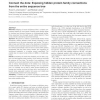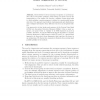148 search results - page 9 / 30 » Inverse Sequence Alignment from Partial Examples |
ECCB
2008
IEEE
15 years 6 months ago
2008
IEEE
Motivation: Mapping of remote evolutionary links is a classic computational problem of much interest. Relating protein families allows for functional and structural inference on u...
110
click to vote
BMCBI
2007
14 years 11 months ago
2007
Background: The analysis of the promoter sequence of genes with similar expression patterns is a basic tool to annotate common regulatory elements. Multiple sequence alignments ar...
101
click to vote
SODA
2010
ACM
15 years 9 months ago
2010
ACM
We give an O(n lg n)-time algorithm for counting the number of inversions in a permutation on n elements. This improves a long-standing previous bound of O(n lg n/ lg lg n) that ...
CVPR
2006
IEEE
16 years 1 months ago
2006
IEEE
We describe a method to align ASL video subtitles with a closed-caption transcript. Our alignments are partial, based on spotting words within the video sequence, which consists o...
COMPLIFE
2005
Springer
15 years 5 months ago
2005
Springer
Abstract. Most software tools in homology recognition on proteins answer only a few specific questions, often leaving not much room for the interpretation of the results. We devel...



